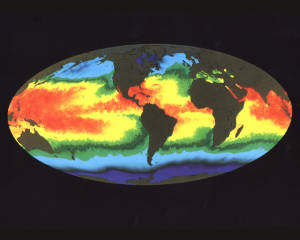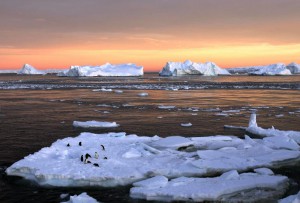Global Climate in 2014 marked by extreme heat and flooding

March 23, 2015 – Record ocean heat, high land-surface temperatures and devastating flooding were some of the defining characteristics of the global climate in 2014, which was nominally the warmest year on record, although by a very small margin, according to a detailed analysis by the World Meteorological Organization (WMO).
The WMO Statement on the Status of the Global Climate in 2014 confirmed the continuation of the warming trend over the past few decades, with 14 of the 15 hottest years on record occurring this century.
The report gave details of national and regional temperatures and precipitation, tropical cyclones, sea level rise and sea ice extent. It included an analysis from the Met Office in the United Kingdom on the human influence on climate, which significantly increased the likelihood of the observed record-breaking temperatures in the United Kingdom in 2014.
The report was released to coincide with World Meteorological Day 23 March which promotes the theme “Climate Knowledge for Climate Action”.
This title was chosen to highlight the progress in climate science and services like seasonal predictions, and to encourage the international community to move this year towards ambitious decisions and actions to address climate variability and change.
“We have sound climate knowledge to inform climate action and to keep climate change impacts to a manageable level. The cost of inaction is high and will become even higher.“ said WMO Secretary-General Michel Jarraud. “We must face our responsibilities to future generations and act to cut greenhouse gas emissions before we run out of time,” he said.
“Multiple lines of evidence – from mounting surface temperatures to shrinking glaciers, from sea-level rise to weather extremes – show that the climate is changing and that this is largely due to human activities, as highlighted by the Fifth Assessment Report of the Intergovernmental Panel on Climate Change”
”The record-breaking temperatures, extreme precipitation and floods we witnessed in 2014 are consistent with what we expect from a warming climate because of increased concentration of greenhouse gases in the atmosphere,“ said Mr Jarraud.
“The ocean is critically important because it absorbs over 93 per cent of the excess heat,” he said. “Sea surface temperatures – and levels – are rising and the heat is penetrating to lower depths. This will have major implications for the future,” said Mr Jarraud.
Highlights of the Statement on the Status of the Climate in 2014
Temperatures:
In 2014, the global average temperature was about 0.57°C (1.03°F) above the 1961-1990 average of 14.00 °C (57.2 °F). This made it nominally the warmest year on record, although the estimate uncertainties in the annual averages are larger than the differences between the warmest years.

In Europe, 19 countries reported record annual temperatures. Western North America including Alaska, eastern Eurasia, much of Africa, large areas of South America and southern and western Australia were also notably warm. Cooler-than-average conditions were recorded across large areas of the United States and Canada.
One of the largest drivers of year-to-year climate variability is the El Niño–Southern Oscillation (ENSO), which is typically associated with elevated global temperatures. It should be noted that 2014 was exceptionally warm despite not being an El Niño year.
Most of the energy that accumulates in the climate system ends up in the oceans. Sea-surface temperatures (SSTs) were much warmer than average across the north and north-east Pacific as well as the polar and subtropical North Atlantic, southwest Pacific, parts of the South Atlantic and much of the Indian Ocean. They were particularly high in the Northern Hemisphere from June to October.
Precipitation
 Global average precipitation in 2014 was close to the long-term average of 1033 mm. The southwest of the U.S.A, northeast China, eastern Brazil and some countries in Central America experienced drought in 2014.
Global average precipitation in 2014 was close to the long-term average of 1033 mm. The southwest of the U.S.A, northeast China, eastern Brazil and some countries in Central America experienced drought in 2014.
Flooding in the Balkan Peninsula in May and June affected Serbia, Bosnia-Herzegovina and Croatia. Heavy rains led to flooding in Bangladesh, Pakistan and India in August and September and in Sri Lanka in December. In Africa, floods affected Morocco, Mozambique, South Africa, Kenya, Ethiopia, Somalia and Tanzania. Flooding in the Parana River basin affected Paraguay, Argentina and Brazil.
Natural climate variability creates such extremes every year, but the high incidence of flooding around the world is consistent with an accelerated hydrological cycle driven by the additional energy trapped in the atmosphere by greenhouse gases.
Ice
Sea ice is an important part of the climate system. It controls the exchange of heat and moisture between the atmosphere and the polar seas and, because it is much more reflective than open water, affects how much solar radiation is absorbed at high latitudes.
According to the U.S. National Snow and Ice Data Center, in 2014 the annual minimum daily Arctic sea ice extent, recorded on 17 September, was 5.02 million km2, the sixth lowest on record.
Melting at the surface of the Greenland ice sheet was above the 1981-2010 average in June, July and August. Summer 2014 was the warmest on record for Kangerlussuaq in West Greenland, the area of highest surface melt. The snow and ice were also darker than in 2013. A lower albedo means that the surface absorbs more sunlight, increasing melt.
Antarctic daily sea ice extents remained at record high levels for much of 2014, and set a new record maximum extent for the third year in a row. Two contributions for the long-term increase are being further examined. The first is that there has been a strengthening of the prevailing westerly winds. The second is that a freshening of the near-surface water due in part to the melting of ice shelves has provided conditions conducive to ice growth.
Tropical Cyclones
Globally, 78 tropical cyclones were recorded during 2014. This is below the total for 2013 (94) and below the 1981-2010 average of 89 storms but exceeds the 67 storms recorded in 2010, the lowest total in the modern satellite era.
Event Attribution
The fast-growing research area of event attribution has been developing new scientific tools to determine the influence of man-made climate change on extreme events by estimating the change in the likelihood of extremes relative to a climate that would not have been influenced by human activity.
The UK’s Met Office applied a new event attribution technique to the global and UK mean record temperature of 2014. “It is estimated that human influence has increased the likelihood of the observed record-breaking temperatures in the UK by a factor of ten,” according to its analysis.
World Meteorological Day
World Meteorological Day commemorates the coming into force on 23 March 1950 of the Convention establishing the World Meteorological Organization. It celebrates the essential contribution that National Meteorological and Hydrological Services make to the safety and wellbeing of society. The theme of this year, “Climate knowledge for climate action” comes as WMO steps up its efforts to improve climate products and services to inform decision-making and action.
Watch WMO Weather Reports 2050 – Canada (English subtitles)







